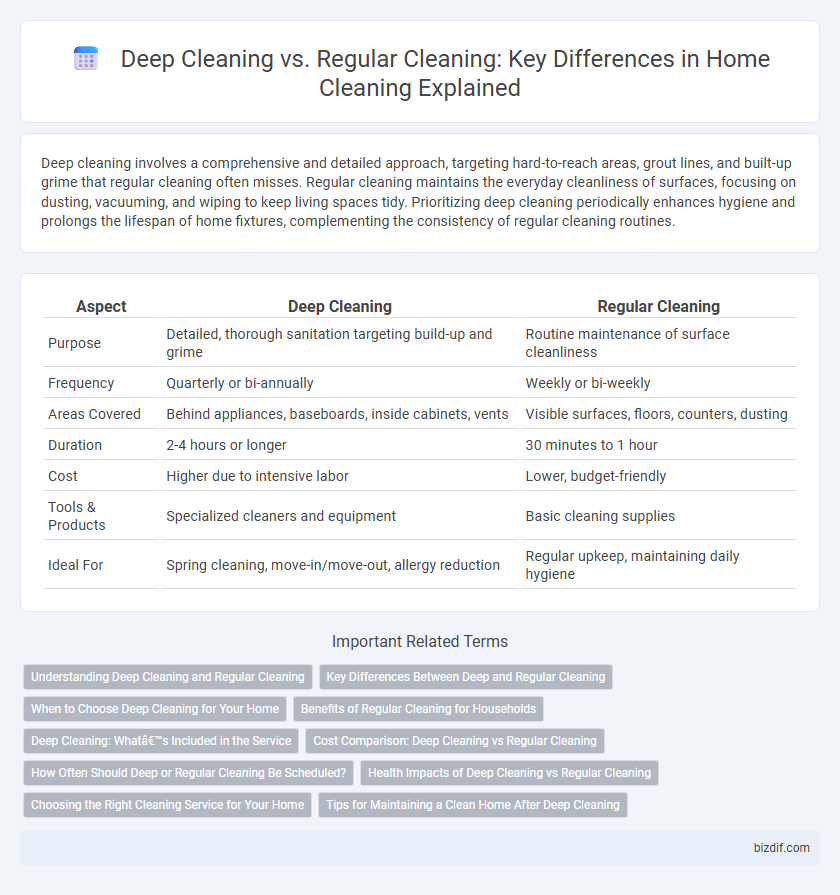Deep cleaning involves a comprehensive and detailed approach, targeting hard-to-reach areas, grout lines, and built-up grime that regular cleaning often misses. Regular cleaning maintains the everyday cleanliness of surfaces, focusing on dusting, vacuuming, and wiping to keep living spaces tidy. Prioritizing deep cleaning periodically enhances hygiene and prolongs the lifespan of home fixtures, complementing the consistency of regular cleaning routines.
Table of Comparison
| Aspect | Deep Cleaning | Regular Cleaning |
|---|---|---|
| Purpose | Detailed, thorough sanitation targeting build-up and grime | Routine maintenance of surface cleanliness |
| Frequency | Quarterly or bi-annually | Weekly or bi-weekly |
| Areas Covered | Behind appliances, baseboards, inside cabinets, vents | Visible surfaces, floors, counters, dusting |
| Duration | 2-4 hours or longer | 30 minutes to 1 hour |
| Cost | Higher due to intensive labor | Lower, budget-friendly |
| Tools & Products | Specialized cleaners and equipment | Basic cleaning supplies |
| Ideal For | Spring cleaning, move-in/move-out, allergy reduction | Regular upkeep, maintaining daily hygiene |
Understanding Deep Cleaning and Regular Cleaning
Deep cleaning involves thorough, intensive cleaning tasks such as scrubbing grout, disinfecting surfaces, and reaching hidden areas to remove deep-seated dirt and allergens. Regular cleaning focuses on everyday maintenance tasks like dusting, vacuuming, and wiping surfaces to keep the home tidy and hygienic. Understanding the distinction helps homeowners schedule appropriate cleaning services for optimal health and upkeep.
Key Differences Between Deep and Regular Cleaning
Deep cleaning targets hidden dirt and grime in hard-to-reach areas such as behind appliances, inside cupboards, and under furniture, while regular cleaning focuses on surface-level tasks like dusting, vacuuming, and wiping countertops. Deep cleaning involves intensive scrubbing of bathrooms, kitchens, and floors, tackling mold, grease, and buildup that regular cleaning often overlooks. The frequency of deep cleaning is typically quarterly or biannually, whereas regular cleaning is performed weekly or biweekly to maintain general cleanliness.
When to Choose Deep Cleaning for Your Home
Deep cleaning is essential when tackling neglected areas like behind appliances, vents, and baseboards that accumulate dust, grime, and allergens over time. Choose deep cleaning before seasonal changes, after hosting large gatherings, or when moving in or out to ensure a thorough sanitization. Regular cleaning maintains daily cleanliness but deep cleaning targets embedded dirt and enhances indoor air quality for a healthier home environment.
Benefits of Regular Cleaning for Households
Regular cleaning maintains a healthy living environment by reducing dust, allergens, and bacteria that accumulate daily. Consistent upkeep prevents the buildup of grime and stains, which helps preserve surfaces and extends the lifespan of household items. Routine cleaning also saves time and effort by minimizing the need for intensive deep cleaning sessions, making household maintenance more manageable.
Deep Cleaning: What’s Included in the Service
Deep cleaning includes thorough tasks such as scrubbing grout, sanitizing baseboards, and cleaning inside appliances like ovens and refrigerators, which are often missed in regular cleaning. It targets hard-to-reach areas, removing deep dirt, allergens, and bacteria to enhance indoor air quality and home hygiene. This comprehensive service typically covers detailed dusting, vacuuming upholstery, and disinfecting high-touch surfaces for a healthier living environment.
Cost Comparison: Deep Cleaning vs Regular Cleaning
Deep cleaning typically costs between $200 and $400 for an average-sized home, reflecting its thorough approach targeting hard-to-reach areas and built-up grime. Regular cleaning services usually range from $80 to $150 per visit, focusing on maintaining surface cleanliness and general upkeep. The higher price of deep cleaning is justified by its intensive labor, specialized tools, and longer duration compared to routine cleaning tasks.
How Often Should Deep or Regular Cleaning Be Scheduled?
Regular cleaning should be scheduled weekly or biweekly to maintain surface cleanliness and prevent dust buildup, while deep cleaning is recommended every three to six months to thoroughly address hidden dirt, mold, and allergens. High-traffic areas and homes with pets or allergy sufferers may require more frequent deep cleaning to ensure optimal hygiene. Consistent scheduling of both cleaning types supports a healthier living environment and prolongs the lifespan of home surfaces and furnishings.
Health Impacts of Deep Cleaning vs Regular Cleaning
Deep cleaning removes stubborn bacteria, allergens, and mold from surfaces often missed in regular cleaning, significantly reducing risks of respiratory issues and infections. Regular cleaning mainly targets visible dirt and dust but may leave behind harmful pathogens, compromising indoor air quality and overall health. Prioritizing deep cleaning enhances hygiene standards, leading to a healthier living environment and improved wellbeing.
Choosing the Right Cleaning Service for Your Home
Deep cleaning targets stubborn dirt and hard-to-reach areas, offering a thorough sanitation that extends beyond the surface-level tasks of regular cleaning. Choosing between deep cleaning and regular cleaning depends on your home's specific needs, frequency of cleanings, and any special circumstances such as post-renovation or allergy concerns. Prioritize deep cleaning for intensive maintenance or seasonal refresh, while regular cleaning suits ongoing upkeep and day-to-day hygiene.
Tips for Maintaining a Clean Home After Deep Cleaning
Maintaining a clean home after deep cleaning involves adopting daily habits such as wiping surfaces immediately after use, regularly decluttering to prevent buildup, and scheduling weekly cleaning tasks like vacuuming and dusting. Using microfiber cloths and eco-friendly cleaning products helps preserve cleanliness while protecting surfaces. Consistent upkeep reduces the need for frequent deep cleaning and ensures a healthier living environment.
Deep Cleaning vs Regular Cleaning Infographic

 bizdif.com
bizdif.com